Up at eight for a huge breakfast and more water before rushing to get to the kiosk for tickets to go inside the Great Pyramid. I would hazard a guess that everyone visiting Egypt wants to go inside — for many, this is the major site they visit in Egypt and their trip is not complete without standing inside this mountain of stone. The number of people allowed inside is limited, however, so tickets are in great demand.
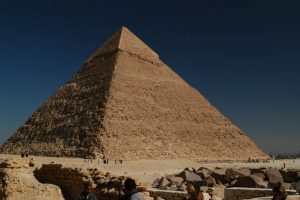
We have a distinct advantage, though. The entrance to the plateau is just up the street from our hotel and we are first in line to enter. When the gates open (at 8:30), the gathering horde of tourists bolts pell-mell up the road to the ticket kiosk. We drove to the top, where Mr. Fatteh got out and ran to the booth to be the first in line (he’s a large man and it’s the only time we ever saw him move at a speed beyond a stately walk). It complicates matters that tickets to the plateau are at one end of the site, and then the “extra” ticket to go into the Great Pyramid must be obtained from another booth at the other end.
Giza Plateau
Inside the Pyramid
Fatteh gave us a running commentary of the history of the pyramid and its excavation as he walked us to the base of the pyramid, since he will not be able to enter the pyramid with us (this is common — many places do not allow guides inside).
The current entrance to the pyramid is not the original. The “real” entrance is another 30-40 feet up the steep side. Grave robbers in the 9th century blew this hole into the pyramid searching for treasure. They knew what they were doing, though; their crudely dug passage meets up with the original corridors inside after only a few yards.
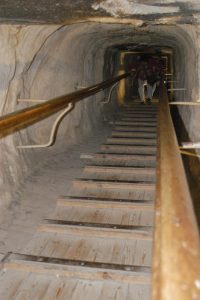
With a final glance to the peak of the pyramid hundreds of feet above, we ducked inside and begin climbing the 45° inclined ramp into the heart of the pyramid itself. We were the first people into the pyramid. A custodian/guard led the way and I wondered how many times a day he made this climb.
There’s a short stop about halfway up with a passageway to the Descending Corridor. It is blocked off, but has a little space for those of us begriming to feel a bit claustrophobic and gasping to take a breather. The passage leads on to the smaller Queen’s chamber inside the pyramid, although no Queen is actually buried there. With creaking knees, we start up again through the tall, corbelled passage called the Grand Gallery. I got partway up and had a serious panic attach – I tried again and simply couldn’t go up any further. It’s not that the space is that small — the ceiling of the gallery is something like 40′ tall – but it is too…heavy. Once I thought about it, the space was simply too small to have that much stone above it. There was suddenly too little air. Eek.
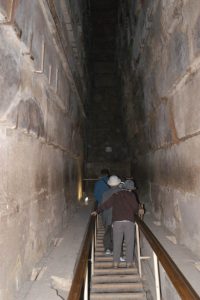
Mark went all the way up and took some pictures of the corbelled ceiling and passages in the Kings Chamber. I waited in the vestibule with a nice Italian lady who also explained that it was “poco!” Too small! I was feeling better after a while, but not enough to make the rest of the climb. I was quite emphatic that I wasn’t going to do that again! I’ve never had any problems with small spaces before, it was just the tons of stone over my head that made my brain spazz out, I think.
The Great Pyramid

Everyone has seen photos of the pyramids, Discovery channel specials…but nothing quite prepared me for the sheer size of the things. You can’t help but be a little awed when standing at the base of the Great Pyramid, and try to comprehend the colossal effort it must have taken to build it. Until the middle of the last century, they were the tallest man-made structure on earth. That anyone would build such a monument, on such a scale, is mind-boggling. Some of the blocks near the bottom are nearly as tall as I am, and I am glad that they no longer allow tourists to climb the outside of the pyramid, as they used to. I’m sure that Mark would want to try and that kind of climb might just kill me!

I had been expecting that they might not seem as “monumental” in real life, since I knew that most of the pictures of the pyramids are deceiving — the city rushes right up to the base of the plateau like an inexorable tide. They are not, as most pictures imply, miles out into the desert surrounding by nothing. There is a Kentucky Fried Chicken restaurant nearly at the toes of the Sphinx.
But were they impressive? You betcha. When you stand at the base of the pyramid and stare up at the millions of pounds of stone…it takes your breath away. I cannot imagine how — or even why — these were built. They seem almost unreal.
Solar Boat

We walked around the base of the pyramid, still a bit overwhelmed, then went to the solar boat museum. In 1954, excavators found a complete cedar wood boat in pieces in a 40 m pit near the pyramid. After years of reconstruction the boat is displayed in the museum fully assembled. The wooden pieces of the boat’s hull are laced together with ropes — not a peg or nail was used in the whole ship. There is some evidence that it was actually sailed, so perhaps it was used in the procession of the dead kings mummy. There are other pits that have been identified near the pyramid, so it is likely that other boats are still buried here.
It looks like the viking boat museum in Norway, Mark says. Even the boat is similar – broad, flat, with a high raised prow and bow/stern ornaments. Put a dragon head on it and you could easily imagine going a-viking in it.
We did get a good laugh at the museum building itself, though. Soviet-era architecture at its plain, unadorned, functional best.
Khafre (Chephren) Pyramid

The pyramid of Chephren (the second pyramid) is very close to the Great Pyramid, much closer than I imagined. Strangely, it seems larger than the Great Pyramid since its foundation stands on higher ground. Unlike the crumbled peak of it’s older neighbor, the top of this pyramid is still clad in limestone – the capstone (pyramidion) is missing, but the top ¼ of the pyramid remains smooth and partially finished and gives a good idea of how it should have looked.
Looking at the rough rubble faces of the pyramids, it is hard to imagine how things looked when they were completed. Fatteh had told us that at least part of the pyramid was painted red while the rest of the cladding was white. As evidence, he notes that the symbol for a pyramid in hieroglyphs shows a red band around the bottom.
Of course, we’ve lost Fatteh by this point. He has retreated to the van with Mr. Mohammed. Luckily, he has figured out our modus operandi – we want lots of info and then to be let loose. We walked around the foundation of Chephren’s pyramid (disregarding Fatteh’s instructions to stay away from the “back side” if we wanted to avoid being hustled), unsuccessfully fended off the extremely persistent camel drivers and got some really great pictures of the pyramid plateau. Mark disappeared to find the causeway and I took a quick look at the mastabas near the Great Pyramid. I had several offers to “open just for you, miss!” from local touts, but they left me alone instantly when I said I would wait for my husband. When Mark finally returned, they were nowhere to be found and we couldn’t get inside. Figures.
Menkaure Pyramid
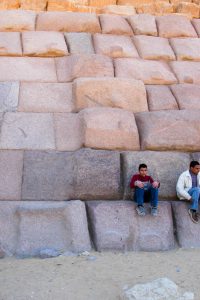
The smallest “big” pyramid on the plateau is Menkaure’s, which seems tiny in comparison to the others. It is still partially clad in gray granite, and for the first time you can see how the casing stones were applied: they were fitted in place roughly, then smoothed out after they were laid. This pyramid is much more damaged than the others — excavators in the 19th century used dynamite to try to blow a hole directly down through the top to find the “treasure”.
The tiny “Queen’s Pyramids” aligned along its side are little more than crumbled ruins. One is attributed to Henutsen, who (according to legend) built the pyramid out of blocks given to her as payment for her…ah, services. Other stores have her father, Menkaure, forcing her into prostitution to pay for his monument. Both stories are, I assume, elaborate fiction.
The Plateau
We hiked back up the hill and drove to the overlook that sits above the plateau. It’s a haphazard bazaar, really, with tents and stalls of postcard sellers and piles of other goods, but the view are superb. We edged out on the rocks to get some good pictures of all the pyramids. I’m still amazed at how close they are to Cairo. From the photos I’ve seen, they look as if they are miles out into the desert. In reality, the city has begun to engulf them. It’s hard to get a picture of the pyramids without the city.
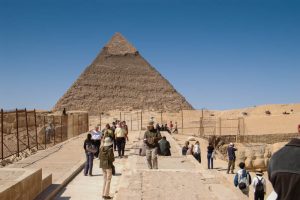
The tourist police are everywhere (although not following us today). We saw a ton of young men in uniform on camels around the pyramids, just watching. Most are quite young, and they speak English as well as a smattering of other languages, and can be relied on to assist tourists if the touts and camel-drivers get too pushy. From what we can see, most of them are well-armed, although the rumor is there is little, if any, ammunition! From the state of their uniforms and equipment, they don’t make much money at all; they are not shy about asking for a few “American Dollars” to pose for pictures.
They’ve been very visible since being created in response to the Luxor massacre in 1997. “Tourist” police apparently weren’t as overtly present before, but one of the guards told us that Asian tourists like the visibility of uniforms (it makes them feel secure) so the green uniforms and black armbands are everywhere. Sometimes they are a bit too visible, and you have the distinct feeling of being watched and followed. They spent the day tracking our whereabouts and writing our license plate down to radio to each place we went.
Funerary Temple
The sphinx is entered via the Funerary Temple of Chephren just to its left. The temple is small and very plain – square columns and rough hewn walls of red granite. Fatteh told us that each one of the huge blocks was carefully measured and the specs sent to the quarry, where they were cut exactly (sometimes with five or six angles) and dry fitted at the quarry before being moved here. Another theory is that they were roughly hewn in place and then the rooms were cut out of them, resulting in the strange multi-angle corners and strangely shaped pieces of stone
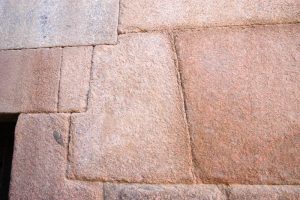
There are some interesting stones, including one that is similar to the shape and style of Inca building. There is an open question as to how far the Egyptians traveled (Thor Heyerdahl believes that they may have been wide-traveling). Fatteh insists that the Egyptians invented boomerangs, and points to similarities in aboriginal writings in Australia to prove it.
The square columns in the t-shaped hall are undecorated, but absolutely even. They are set about 1/3 into the floor, in holes so tightly fit that we could barely see the seams. To get these huge blocks set, the holes were filled with sand and the blocks set upright on it, then the sand was siphoned out from below, until the columns were lowered all the way down. This is the same way that huge stone sarcophagi, etc, where lowered in place in tombs, we were told.
There are 23 holes in the floor where alabaster statues of Khafrae would have been placed. The ritual statues would have been quite striking, Fatteh said. They would wear the 2 colored-crown of Upper and Lower Egypt, with the nemes headdress painted white, and the cobra (Fatteh always says “Snake of Cobra”, which has started to make me giggle) on the brow decorated with eyes of cornelian (red). Of course, none of them actually stand here. They were mostly destroyed. In fact, only a tiny little statue of Khafre was ever found to link him to the pyramid complex.
A small room of the main hall was blocked off, but we could peer into the darkness to see the tables inside. It would have contained the necessary preparations for the 70 days of mummification. Sesame oil lamps to which salt has been added to eliminate the smoke would have lit the entire temple.
The entire purpose of this temple complex would have been to prepare the king for burial with the necessary mummification rituals. Three levels of mummification exist – for the poor, for the wealthy, and for the king. The poor were buried in the fetal position in baskets in the sand. The rich were wrapped in linen and buried in sarcophagi and the king had the whole shebang – removing all the internal organs except the heart and kidneys (including the brain with a long hook), anointed and perfumed and wrapped in 18 layers of linen with jewels, 40 days in natron salts to dry out the body, then the journey to Memphis and back for the whole funerary procession thing. It was good to be king.
Sphinx
The sphinx is much lower than the surrounding pyramids, and surrounded by a high enclosure wall – we were not able to go down to walk between the huge paws, but we did walk down the alabaster causeway to view it from the valley temple. Tons of vendors are here – mostly kids selling postcards and bookmarks and other things – swapping one language with another with ease.
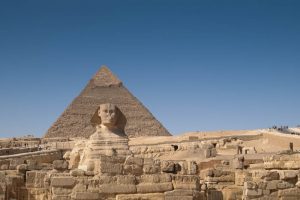
I heard Arabic, English, Japanese, Chinese, Russian, French, Italian, and German in one short walk. Amazing.
Several of the kids seemed genuinely surprised that we were Americans. They were all very polite and wanted us to know that “American is number one!” or that they liked Americans. They’re leery of Mark, though. When I point to “my husband”, most of them scatter to avoid giving offense. I don’t think too many Americans are here – the bulk of the tourists are Chinese or German or French.
To be completely honest, the Sphinx isn’t as spectacular as I’d expected it to be, especially compared to the pyramids. For one thing, it’s actually quite small and (at least to me) the head is too tiny for the enormous body. I’m lending more and more credence to the theories that say the Sphinx is far older than the pyramids and was re-carved with its current head. The base is very damaged, and repairs over the centuries have often made the problem worse, not better.
We had our first camel ride in the cemetery beyond the Sphinx – the young men leading the camels wanted big tips, but were nice and easy-going. Mark took lots of pictures of me getting on the camel. He laughed. I kept waiting for him to fall off, but I was sadly disappointed.
Dashur
We stopped for a quick seafood lunch and then off to Dashur (about half an hour from Cairo). It’s near a military base, so there are many solders and blockades nearby. The pyramids here (there are two large ones and a half-dozen smaller structures) are honestly more spectacularly placed than those at Giza. For miles, all there is around them is desert and they rise from the flat bedrock like sentinels. No tourist busses here, and no extravagant “visitors centers”…just the pyramids and a few tourist police.
Red Pyramid
Most people come here to see the Red Pyramid and the Bent Pyramid. The Red Pyramid is smaller, but is the first “true” pyramid. Mark climbed up and in and scrambled down into the pyramid itself. I got to the entrance and balked. Despite Fatteh’s advice (“go down backwards and keep your eyes on the doorway, and chew gum or suck pebbles to keep your mouth from drying out! It will be ok! Really!”) I sat outside and let Mark go down by himself. I never knew that I was claustrophobic. I feel a bit better that it took 2 ½ million blocks of stone over my head to cause problems, though.
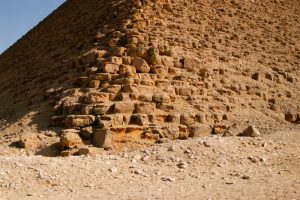
A new ventilation system was in place – and Mark said the lack of oxygen and airplane glue smell gave him a serious buzz. He looked pretty shaky at the top when he emerged from the small corridor. The walk down (about 90′ at forty-five degrees) was a trial on his knees. Inside are no decorations or carvings – just three rooms, which are just below ground level (even though you enter the pyramid halfway up the side). His pictures inside show elaborate bracing and some of the original cedar wood beams. The final goal — the burial pit — is a bit of a letdown.
The “filling” stones of the pyramid have hematite and limonite in them. The outsides are reddish, but in the light the stone has a yellowish cast. The pyramid is in poor condition and the base is surrounded by piles of rubble that have sifted away from the sides.
Bent Pyramid
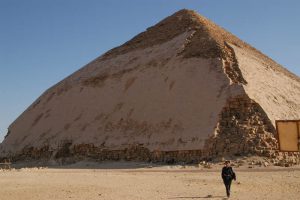
The Bent Pyramid nearby is really impressive – it seems much larger than the others because it is so complete. It’s patently obvious that they started out far too steeply an had to abruptly change to a 45 degree angle in order to avoid collapse.
It is thought that the Bent and Red pyramids were finished by Sneferu (father of Cheops who built the Great Pyramid). The two pyramids here stand alone–no visible temples even though they must have had full mortuary temples, causeways, and valley temples down near the Nile when they were built. There are just dunes, which must hide mastabas and walkways and other treasures.
Black Pyramid
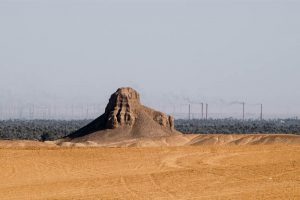
In the distance is the mud brick ruin of the (Black Pyramid) Pyramid of Senusert I. The stone core still stands, but the entire pyramid has fallen. It almost looks like a natural outcropping of rock. We did not investigate it, but apparently the internal structure is complex and interesting.
Abu Sir
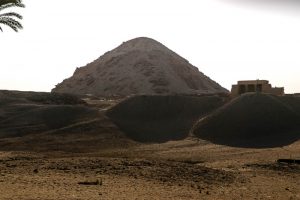
On the way back to Cairo we stopped at a small dead-end street to get some pictures of Abu-Sir. According to Fatteh, the site is closed. There are a number of ruined pyramids here, and the remains of two enormous Sun Temples. From the barricade, we could only snap pictures of the pyramids against the sunset before the argument broke out.
The family living near the barricade apparently wanted a fee for taking the photos – Mr. Fatteh was quite adamant that it was not legal and argued that we were taking pictures of a public thing in the distance and no fee was warranted and then had to invoke “important people” in the nome to get them to back off. We decided that discretion was the better part of valor and climbed into the van and stayed out of it. After the yelling and animated gesticulating, Fatteh and the father of the family shook hands, seemed to wish everyone the best, and we left.